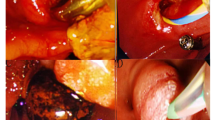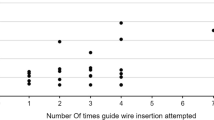Abstract
Patients with combined choledocholithiasis and cholecystitis require treatment of both diseases. The aim of our study was to analyze perioperative results of next-day (< 24 h) vs. early (> 24 h) laparoscopic cholecystectomy (LC) after endoscopic clearance of common bile duct stones. We conducted a retrospective study of patients that underwent LC after endoscopic treatment of choledocholithiasis, with combined diagnoses of common bile duct stones (with or without acute cholangitis) and gallbladder stones (with acute or chronic cholecystitis). From January 2014 to May 2017, 87 patients underwent LC after endoscopic sphincterotomy: 40 patients within 24 h (NDLC) and 47 after 24 h (ELC). Regarding pre-ERCP diagnosis, 29 (72.5%) of patients in the NDLC group and 33 (70.2%) of patients in the ELC group had high-risk of choledocholithiasis (p = 0.814), acute cholecystitis (32.5 vs. 25.5%, p = 0.474) and acute cholangitis (17.5 vs. 17%, p = 0.953). The median time from ERCP to LC was 23 h (IQR 22–23) in the NDLC group and 72 h (IQR 48–80) in the ELC group (p < 0.001). No statistically significant differences were found in regard to operative time, estimated blood loss, overall morbidity and rate of conversion to open surgery. Patients in the NDLC group had a shorter total length of stay (2 vs. 4 days, p < 0.001). Laparoscopic cholecystectomy performed within the first 24 h after endoscopic treatment of choledocholithiasis is safe and feasible, without increased postoperative morbidity and associated with reduction of the hospital length of stay.
Similar content being viewed by others
References
Reinders JS, Goud A, Timmer R et al (2010) Early laparoscopic cholecystectomy improves outcomes after endoscopic sphincterotomy for choledochocystolithiasis. Gastroenterology 138:2315–2320
Wakabayashi G, Iwashita Y, Hibi T et al (2017) Tokyo guidelines 2018: surgical management of acute cholecystitis: safe steps in laparoscopic cholecystectomy for acute cholecystitis. Hepatobiliary Pancreat Sci. https://doi.org/10.1002/jhbp.517
Borreca D, Bona A, Bellomo MP et al (2015) “Ultra-rapid” sequential treatment in cholecystocholedocholithiasis: alternative same-day approach to laparoendoscopic rendezvous. Updates Surg 67:449–454
Allen NL, Leeth RR, Finnan KR et al (2006) Outcomes of cholecystectomy after endoscopic sphincterotomy for choledocholithiasis. J Gastrointest Surg 10(2):292–296
Boerma D, Rauws EA, Keulemans YC et al (2002) Wait-and-see policy or laparoscopic cholecystectomy after endoscopic sphincterotomy for bile-duct stones: a randomised trial. Lancet 360:761–765
Wild JL, Younus MJ, Torres D et al (2015) Same-day combined endoscopic retrograde cholangiopancreatography and cholecystectomy: achievable and minimizes costs. J Trauma Acute Care Surg 78:503–507
De Vries A, Donkervoort SC, Van Geloven AAW et al (2005) Conversion rate of laparoscopic cholecystectomy after endoscopic retrograde cholangiography in the treatment of choledocholithiasis. Surg Endosc 19:996–1001
Mayumi T, Okamoto K, Takada T et al (2017) Tokyo guidelines 2018: management bundles for acute cholangitis and cholecystitis. J Hepatobiliary Pancreat Sci. https://doi.org/10.1002/jhbp.519
Kiriyama S, Kozaka K, Takada T et al (2017) Tokyo guidelines 2018: diagnostic criteria and severity grading of acute cholangitis (with videos). J Hepatobiliary Pancreat Sci. https://doi.org/10.1002/jhbp.512
Adler DG, Baron TH, Davila RE et al (2005) ASGE guideline: the role of ERCP in diseases of the biliary tract and the pancreas. Standards of Practice Committee of American Society for Gastrointestinal Endoscopy. Gastrointest Endosc 62(1):1–8
Dindo D, Demartines N, Clavien PA (2004) Classification of surgical complications: a new proposal with evaluation in a cohort of 6336 patients and results of a survey. Ann Surg 240(2):205–213
Strasberg SM, Brunt LM (2010) Rationale and use of the critical view of safety in laparoscopic cholecystectomy. J Am Coll Surg 211(1):132–138
Schiphorst AHW, Besselink MGH, Boerma D et al (2008) Timing of cholecystectomy after endoscopic sphincterotomy for common bile duct stones. Surg Endosc 22:2046–2050
Friis C, Rothman JP, Burcharth J et al (2017) Optimal timing for laparoscopic cholecystectomy after endoscopic retrograde cholangiopancreatography: a systematic review. Scand J Surg 1:1457496917748224
Bansal VK, Misra MC, Rajan K et al (2014) Single-stage laparoscopic common bile duct exploration and cholecystectomy versus two-stage endoscopic stone extraction followed by laparoscopic cholecystectomy for patients with concomitant gallbladder stones and common bile duct stones: a randomized controlled trial. Surg Endosc 28(3):875–885
Ding G, Cai W, Qin M (2014) Single-stage vs. two-stage management for concomitant gallstones and common bile duct stones: a prospective randomized trial with long-term follow-up. J Gastrointest Surg 18(5):947–951
Salman B, Yilmaz U, Kerem M et al (2009) The timing of laparoscopic cholecystectomy after endoscopic retrograde cholangiopancreaticography in cholelithiasis coexisting with choledocholithiasis. J Hepatobiliary Pancreat Surg 16:832–836
Bostanci EB, Ercan M, Ozer I et al (2010) Timing of elective laparoscopic cholecystectomy after endoscopic retrograde cholangiopancreaticography with sphincterotomy: a prospective observational study of 308 patients. Langenbecks Arch Surg 395:661–666
Kwon YH, Cho CM, Jung MK et al (2015) Risk factors of open converted cholecystectomy for cholelithiasis after endoscopic removal of choledocholithiasis. Dig Dis Sci 60:550–556
Wright BE, Freeman ML, Cumming JK et al (2002) Current management of common bile duct stones: is there a role for laparoscopic cholecystectomy and intraoperative endoscopic retrograde cholangiopancreatography as a single-stage procedure? Surgery 132:729–735
Peponis T, Panda N, Eskesen TG et al (2018) Preoperative endoscopic retrograde cholangio-pancreatography (ERCP) is a risk factor for surgical site infections after laparoscopic cholecystectomy. Am J Surg. https://doi.org/10.1016/j.amjsurg.2018.09.033
Morino M, Baracchi F, Miglietta C et al (2006) Preoperative endoscopic sphincterotomy versus laparoendoscopic rendezvous in patients with gallbladder and bile duct stones. Ann Surg 244:889–893
Tzovaras G, Baloyiannis I, Zachari E et al (2012) Laparoendoscopic rendezvous versus preoperative ERCP and laparoscopic cholecystectomy for the management of cholecystocholedocholihiasis. Ann Surg 255:435–439
Funding
This research did not receive any specific grant from funding agencies in the public, commercial, or not-for-profit sectors.
Author information
Authors and Affiliations
Corresponding author
Ethics declarations
Conflict of interest
The authors declare that they have no conflicts of interest.
Research involving human participants and/or animals
All procedures performed in studies involving human participants were in accordance with the ethical standards of the institutional and/or national research committee and with the 1964 Helsinki declaration and its later amendments or comparable ethical standards.
Informed consent
No informed consent was required due to the retrospective nature of the study.
Additional information
Publisher's Note
Springer Nature remains neutral with regard to jurisdictional claims in published maps and institutional affiliations.
Rights and permissions
About this article
Cite this article
Trejo-Ávila, M., Solórzano-Vicuña, D., García-Corral, R. et al. Laparoscopic cholecystectomy after endoscopic treatment of choledocholithiasis: a retrospective comparative study. Updates Surg 71, 669–675 (2019). https://doi.org/10.1007/s13304-019-00624-5
Received:
Accepted:
Published:
Issue Date:
DOI: https://doi.org/10.1007/s13304-019-00624-5




